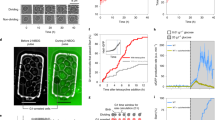Abstract
Conservation of cell cycle control mechanisms is indicated by the presence of functionally homologous division control genes in unrelated yeasts1 and by the nonspecific action of oncogenes2,3, but it remains uncertain what property of a growing cell results in the initiation of events leading to division. Response to a critical size is indicated by the longer growth period of smaller cells prior to division4–6, which is consistent with deferment of division events until a minimum size is attained; however, in the same cell types faster growing cells are larger7–9 and this is more easily explained if division follows a timed period during which faster growing cells grow more, as is postulated for mammalian cells10–11. Therefore, either time-or size-dependent controls might be the sole significant mechanism12,13; we report here, however, that both controls do function in Chlamydomonas since cycle duration is under timer control and cell size determines the number of division rounds committed at the end of each cycle, and hence whether 2, 4, 8 or 16 daughter cells are formed.
This is a preview of subscription content, access via your institution
Access options
Subscribe to this journal
Receive 51 print issues and online access
$199.00 per year
only $3.90 per issue
Buy this article
- Purchase on Springer Link
- Instant access to full article PDF
Prices may be subject to local taxes which are calculated during checkout
Similar content being viewed by others
References
Beach, D., Durkacz, B. & Nurse, P. Nature 300, 706–709 (1982).
Logan, J. & Cairns, J. Nature 300, 104–105 (1982).
Colby, W. W., Chen, E. Y., Smith, D. H. & Levinson, A. D. Nature 301, 722–725 (1983).
Fantes, P. A. J. Cell Sci. 24, 51–67 (1977).
Johnston, G. C., Pringle, J. R. & Hartwell, L. H. Expl Cell Res. 105, 79–98 (1977).
Shields, R., Brooks, R. F., Riddle, P. N., Capallero, D. F. & Delia, D. Cell 15, 469–474 (1978).
Fantes, P. A. & Nurse, P. Expl Cell Res. 107, 377–386 (1977).
Jagadish, M. N., Lorincz, A. & Carter, B. L. A. FEMS microbiol. Lett. 2, 235–237 (1977).
Tovey, M. & Brouty-Boye, D. Expl Cell Res. 101, 346–354 (1976).
Smith, J. A. & Martin, L. in Cell Cycle Controls (eds Padilla, G. M., Cameron, I. L. & Zimmerman, A.) 43–60 (Academic, New York, 1974).
Brooks, R. F., Bennett, D. C. & Smith, J. A. Cell 19, 493–504 (1980).
Brooks, R. F. Soc. exp. Biol. Semin. Ser. 10, 35–61 (1981).
Pardee, A. B., Shilo, B. Z. & Koch, A. L. in Hormones and Cell Culture (eds Sato, G. & Ross, R.) 373–392 (Cold Spring Harbor Laboratory, New York, 1979).
Tamiya, H., Iwamura, T., Shibata, K., Hase, E. & Nihei, T. Biochim. biophys. Acta 12, 23–40 (1953).
Wanka, F. Arch. Mikrobiol. 34, 161–188 (1959).
Howell, S. H., Blaschko, W. J. & Drew, C. M. J. Cell Biol. 67, 126–135 (1975).
Spudich, J. L. & Sager, R. J. Cell Biol. 85, 136–145 (1980).
Daan, S. in Biological Timekeeping, Soc. exp. Biol. Semin. Ser. (ed. Brady, J.) 11–32 (Cambridge University Press, London, 1982).
Molloy, G. R. & Schmidt, R. R. Biochem. biophys. Res. Commun. 40, 1125–1133 (1968).
Kates, J. R., Chiang, K. S. & Jones, R. F. Expl Cell Res. 49, 121–135 (1968).
Mihara, S. & Hase, E. Pl. Cell Physiol., Tokyo 12, 225–236 (1971).
Poyton, R. O. J. Bact. 113, 203–211 (1973).
John, P. C. L., Lambe, C. A., McGookin, R., Orr, B. & Rollins, M. J. J. Cell Sci. 55, 51–67 (1982).
Edmunds, L. N. & Adams, K. J. Science 211, 1002–1013 (1981).
Lees, A. D. J. Insect Physiol. 19, 2279–2316 (1973).
Nurse, P. Nature 286, 9–10 (1980).
Rollins, M. J., Harper, J. D. I. & John, P. C. L. J. gen. Microbiol. 129, 1899–1919 (1983).
Coleman, A. W. J. Phycol. 18, 192–195 (1982).
Author information
Authors and Affiliations
Rights and permissions
About this article
Cite this article
Donnan, L., John, P. Cell cycle control by timer and sizer in Chlamydomonas. Nature 304, 630–633 (1983). https://doi.org/10.1038/304630a0
Received:
Accepted:
Issue Date:
DOI: https://doi.org/10.1038/304630a0
This article is cited by
-
Nitrogen-dependent coordination of cell cycle, quiescence and TAG accumulation in Chlamydomonas
Biotechnology for Biofuels (2019)
-
Growth and the cell cycle in green algae dividing by multiple fission
Folia Microbiologica (2019)
-
Cell-size dependent progression of the cell cycle creates homeostasis and flexibility of plant cell size
Nature Communications (2017)
-
Group Selection and Group Adaptation During a Major Evolutionary Transition: Insights from the Evolution of Multicellularity in the Volvocine Algae
Biological Theory (2014)
-
Stationary Size Distributions of Growing Cells with Binary and Multiple Cell Division
Journal of Statistical Physics (2011)
Comments
By submitting a comment you agree to abide by our Terms and Community Guidelines. If you find something abusive or that does not comply with our terms or guidelines please flag it as inappropriate.



